单选题In writing,students may not know how to put something into proper English and thus ask their teacher for help.Here the teacher is to play the role of a/an .A facilitatorB assessorC controllerD participant
题目
facilitator
assessor
controller
participant
相似考题
更多“单选题In writing,students may not know how to put something into proper English and thus ask their teacher for help.Here the teacher is to play the role of a/an .A facilitatorB assessorC controllerD participant”相关问题
-
第1题:
In which of the following situations does the teacher play the role of organizer?A.Organizing students to do activities by giving instructions.
B.Walking around to offer help to those who need it both in ideas and language.
C.Giving feedback and dealing with errors.
D.The teacher joins in students’ activity.答案:A解析:本题考查教师的角色。
A选项,由关键词“organize”可知,教师的角色为组织者。综上,A选项正确。
B选项,提供给学生帮助,教师的角色为推动者。
C选项,给予反馈,教师的角色为评价者。
D选项,教师参与到学生活动中,教师的角色为参与者。
故正确选项为A。 -
第2题:
Which role does the teacher play in the following activities? When the students are doing a group work task, the teacher joins one or two groups for a short period of time.A.source of help
B.controller
C.participant
D.assessor答案:C解析:本题考查教师的角色。
根据题干中的关键词“join in”,教师加入小组活动中,真正成为小组活动的一员与小组成员互动,可知正确答案为“participant”,综上,C选项正确。
A选项,资源的帮助者,不合题意,故排除。
B选项,控制者,不合题意,故排除。
D选项,评价者,不合题意,故排除。
故正确选项为C。 -
第3题:
Before doing a writing task, the teacher elicits students′ ideas by asking them to list as many words or phrases that come into their mind about the topic as possible. Here the teacher is playing the role of a(an) __________.
A.controller
B.participant
C.organizer
D.prompter答案:C解析:考查课堂中的教师角色。在英语写作课教学时,让学生以列单的形式把对某一主题所产生的各种想法、事实、例子和感受等以词汇或短语的方式表述出来,这运用的是头脑风暴法.体现了教师的组织者角色。故选C。 -
第4题:
小学英语?语音
一、考题回顾

二、考题解析
【教案】
Teaching aims:
Knowledge aim:
Students will master the meaning and pronunciation of the word.
Ability aim:
Students will know how to pronounce “-er” in words.
Emotional aim:
Students will be interested in learning English.
Key and difficult point:
Key Point:
Students will master the meaning and pronunciation of the word.
Students will know how to pronounce “-er” in words.
Difficult Point:
Students will be interested in learning English.
Teaching procedure:
Step 1: Warming-up
1. Greetings.
2. Sing a song Finger Family.
Daddy finger, daddy finger, where are you?
Here I am, here I am, how do you do?
Mommy finger, mommy finger, where are you?
Here I am, here I am, how do you do?
Ask them if they know the name of the song. Then may guess it is Finger Family. Then tell them that we are going to learn some pronunciation in “finger”.
Step 2: Presentation
1. Use some riddles to introduce the words. For example, “I will drink it every day. What is it? Yes, it’s water.” Then draw the according pictures(introduce “sister” by explaining its meaning). And write the words at last.
2. Ask the students to read the words after the teacher for twice. Then play high and low voice. If the teacher speak one word loudly, the students should speak it lowly, and vice versa.
3. Ask students to find similarities among the words. They may say that they all contain “-er” at the end of the words. Then introduce the rules of the pronunciation.
4. Ask students if they know other words containing “-er”. They may say “winter”, “river” or others.
Step 3: Practice
1. Finish Read, underline, and say in the textbook. Check answers, and ask students to read after the teacher.
2. Finish Look, listen and write in the textbook. Then invite students share their answers on the blackboard. Give encouragement.
Step4: Production
1. Ask students to make up a chant using the words we learned. For example:
Water, water, tiger likes water.
Sister, sister, sister likes computer.
Dinner, dinner, let’s have dinner.
Step5: Summary and Homework
Summary: ask a student to conclude the content of the lesson and summarize with the whole class.
Homework: chant for the students’ parents.
Blackboard design:
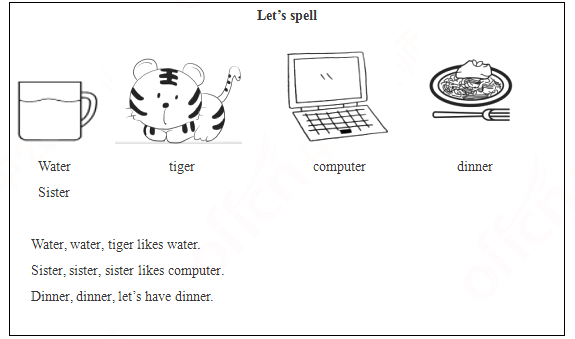
1. What is a good pronunciation lesson?
2. What will you do if one of the students in your class doesn’t do homework?答案:解析:1.
A good pronunciation lesson should make students master the rules of the pronunciation, and they can apply the rules when encounter the syllables in the future. So in my lesson, I firstly let the students find similarities among the words, then I conclude the rules. After that, I ask them if they know other words that share the same pronunciations. Later, few exercises are conducted so that they can consolidate the knowledge. Thus, I believe I have given a good pronunciation lesson.
2.
Firstly, I will ask him or her to finish the homework as soon as possible. Secondly, I will try to talk with the student patiently to figure out the reason. If the student say that they have too much homework, then I will try to reduce the homework amount afterward. If the student think homework is not important, I will tell that homework is a good way to absorb the knowledge learned today, otherwise they will forget it quickly. Lastly, I will talk to his or her parents to let them also focus on the problem and address it together with us. -
第5题:

二、考题解析
【教案】
Teaching Aims:
Knowledge aim: By the end of the class, students will know some expressions of advice and the format of a letter, which includes: an appellation, a body part, a complimentary close and a signature.
Ability aim: Students’ writing ability of letter can be improved by the end of the class.
Emotional aim: Students will be aware of the importance of writing English letter.
Students' interest of learning English can be inspired.
Teaching Key Points:
Students know the format of an English letter and how to make a suggestion.
Teaching Difficult Points:
Students can apply expressions of advice and the format of English letter into their own life.
Teaching Methods:
Communicative teaching method, task-based teaching method, situational teaching method.
Teaching Aids:
PPT, Blackboard and so on
Teaching Procedures:
Step 1: Warming up
1.Greetings
2.Sing an English song We don’t talk anymore, invite the whole students to clap when singing together and lead to the topic.
Step 2: Pre-writing
1.Free talk: Let students talk about the importance of communication in our daily life in group of four, 3 minutes later invite some groups to show their ideas.
2.Set up situation: Let's say our friend Li Ming is very upset recently, because he has a problem in the aspect of communicating with others, we should write a letter to give him some advice.
3.Format: Guide and teach students the format of English letters, which includes: an appellation, a body part, a complimentary close and a signature.
4.Content: Teach students the key sentence structures about how to make a suggestion.(eg: I suggest that you...)
5.Brainstorming: Let students share their ideas about how to communicate with others with their partners, and decide which are the best ideas, make a list of those ideas, then put those ideas into a map so that students can easily see them when they write.
Step 3: While-wirting
Give students some guidance, such as: pay attention to the punctuation, sentence structure, tenses and format. 15 minutes would be given to them to complete their letter within 100 words individually.
Step 4: Post-writing
1.Self-editing: Ask students to check their letter according to the format and sentence structures on the blackboard.
2.Peer editing: Ask students to check and edit their partners’ letter and give them some suggestions.
3.Share: Invite some students to share their letter in front of the class and teacher gives them some comments.
Step 5: Summary & Homework
Summary : Invite a little teacher sum up what we have learned today.
Homework: Let students search more information about how to communicate with others.
 答案:解析:暂无解析
答案:解析:暂无解析 -
第6题:

二、考题解析
【教案】
Teaching aims:
Knowledge aims:
Students will know how to describe a day using proper conjunctions and tense.
Students will master some words, such as waste, value... and a sentence structure: I usually + simple present tense.
Ability aim:
Students will improve their abilities of speaking and listening.
Emotional aim:
Students will be more confident in speaking English.
Key and difficult point:
Key Point: Students will know how to introduce a day in English.
Difficult Point: Students will use the sentence structure in real communicative situation.
Teaching procedure:
Step 1: Warming-up
1. Greetings.
2. Play a video about Tom’s day and ask students what kind of information have they caught.
Step 2: Pre-listening
1. Review the knowledge about simple present tense. Ask students to make sentences using simple present tense.
2.Using pictures to explain some words: waste-value, brush.
Step 3: While-listening
1st listening: Ask students to listen to the tape for the first time and try to get the main idea of the passage and underline the conjunctions used.
2nd listening: Ask students to listen to the tape for the second time and complete the timetable below.
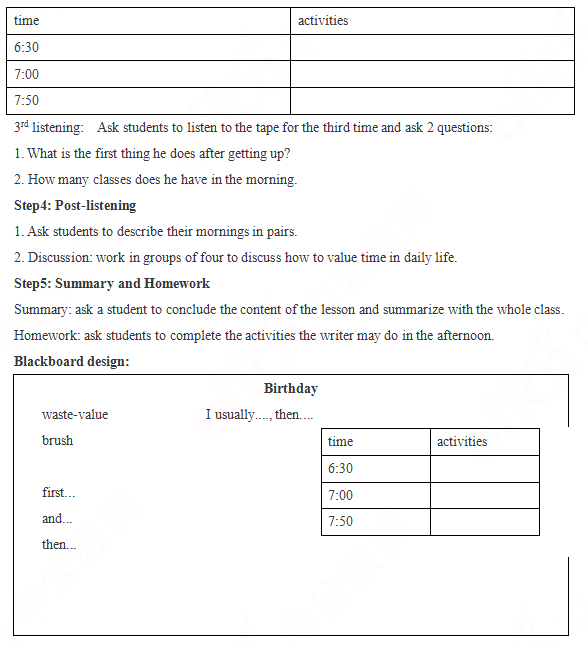 答案:解析:暂无解析
答案:解析:暂无解析 -
第7题:
It is important for the teacher to show students how easy it is to understand something from authentic materials rather than how difficult it is to understand everything.()
A对
B错
对
略 -
第8题:
单选题While doing a writing task either individually or in groups, the students need to use a particular word they don’t know. So they ask the teacher. Here the teacher is playing the role of a(an) _____.Aassessor
Bresource provider
Cparticipant
Dcontroller
正确答案: C解析:
教师是课堂教学的调控者(controller)、促进者(prompter)、参与者(participant)、组织者(organiser)、评估者(assessor)和资源提供者(resource provider)。当学生向教师询问不会的单词时,教师扮演的是资源提供者的角色。 -
第9题:
单选题Before doing a writing task,the teacher elicits students'ideas by asking them to list as many words or phrases that come into their mind about the topic as possible.Here the teacher is playing the role of a(n)________.Acontroller
Bparticipant
Corganizer
Dprompter
正确答案: A解析: -
第10题:
单选题The teacher gives students 2 minutes to skim a text, and when time is stop and answer some questions. Here the teacher is playing the role of a(an)up, he asks students toAassessor
Bprompter
Cparticipant
Dcontroller
正确答案: D解析: -
第11题:
单选题Which role does the teacher play in the following activities? When the students are doing a group-work task, the teacher joins one or two groups for a short period of time.Aorganizer
Bcontroller
Cparticipant
Dassessor
正确答案: C解析: -
第12题:
单选题What role does the teacher play at the feedback stage? _____AAssessor
BInstructor
CManager
DResearcher
正确答案: D解析:
在教学反馈阶段,教师的角色是评估者。 -
第13题:
How should the teacher deal with students' writing errors?A.Teachers should limit students to take risks to use new vocabulary and structures.
B.Teachers should often show negative attitude towards students' writing errors.
C.Teachers should make corrections for all the writing errors of students.
D.Teachers should underline the errors and leave them for students to correct themselves.答案:D解析:考查写作教学。学生在写作中犯错常常是难以避免的情况.但是教师要不怕学生犯错并鼓励他们运用较难的词汇和句子,这样学生的写作能力才会提高,故A错误。教师如果经常对错误持消极的态度,就会阻碍学生的写作热情,不利于写作技能的提高,故B错。教师在批阅作文时,不应该自己把所有的错误都改正,而应该指出错误并让学生自己去改,以培养学生独立写作的能力,C项错误,故选D。 -
第14题:
In writing, students may not know how to put something into proper English and thus ask their, teacher for help. Here the teacher is to play the role of a/an__________A.facilitator
B.assessor
C.controller
D.participant答案:A解析:考查教师的角色。根据题目提供的情境,“写作课上,当学生不知道如何用英语表达某事物时,会向老师寻求帮助”,此时教师扮演了促进者(facilitator)的角色。assessor“评估者”,controller“控制者”,participant“参与者”.均不符合题意。故选A。 -
第15题:
What role does the teacher play in the deductive presentation of grammar?A.Instructor.
B.Prompter.
C.Participant.
D.Negotiator.答案:A解析:本题考查教师的角色。
A选项,传授者,演绎法语法教学中,教师是课堂的主导,是语法规则的教授者。综上,A选项正确。
B选项,推动者,提示者,故排除。
C选项,参与者,故排除。
D选项,协商者,故排除。
故正确答案为A项。 -
第16题:
初中英语?语法
一、考题回顾

二、考题解析
【教案】
Teaching aims:
Knowledge aim:
Students will know the usage of the frequency adverbs and the sentence structure “How often...?”.
Ability aim:
Students can use the sentence structure freely in their daily life.
Emotional aim:
Students will be more confident in learning English and not afraid of speaking English.
Key and difficult point:
Key Point: Students will know how to use the sentence structure in their daily life.
Difficult Point: Students can cultivate their confidence in learning English.
Teaching procedure:
Step 1: Warming-up
1. Greetings.
2. Ask students what they usually do in their spare time and why, and ask some of them to share with the whole class.
Step 2: Presentation
1. Listen to the tape for the first time and find out what the speaker does every day, and then invite students share their answers.
2. Ask students the following questions: how often does the speaker watch TV? How often does the speaker listen to music? And then write down the sentence on the blackboard.
3. Explain the sentence structure to students: the sentence structure is used to ask questions about how many times something has been done or how many times a state exists in a given period of time.
4. The teacher read the dialogue and ask students to read after it to get a deep understanding.
Step 3: Practice
1. Role-play. Ask students work in pairs and role play the dialogue. Then invite two groups to show in front of the class.
2. Play a game: word cards. Invite two couples of students. Ask one student to choose the card in the box and then ask the other students the question “ how often do you...?” using the activities showed in the card, and then change their role.
Step4: Production
Let students work in groups of 4 and discuss on the topic: how often do you...? according to their own hobbies. After that invite two groups to present in the whole class.
Step5: Summary and Homework
Summary: ask a student to conclude the content of the lesson and summarize with the whole class.
Homework: ask students to ask their friends “ how often do you...?” after class and write down on the exercise book.
Blackboard design:

1. Can you tell me the difference between “How often...?” and “How long...?”?
2. What do you usually do in your spare time?答案:解析:1.
The first sentence structure is used to ask questions about how many times something has been done or how many times a state exists in a given period of time. The second sentence structure includes two different usage: one is used to ask how long does it take. It's mainly used to ask questions for a period of time; the other is used to ask for the length of something.
2.
I really have a great passion for sports, i like to do yoga, cycling and jogging. Take jogging for example. It stimulates me to learn more about body -building. Secondly, I am able to meet new friends through my hobby. Lastly, the hobby will teach me some self-discipline, because to do it regularly is so challenging. -
第17题:

二、考题解析
【教案】
Teaching aims
Knowledge aim: students will know the pronunciation of the group of letter “ear”.
Ability aim: students can read words with “ear” when they learn vocabulary.
Emotional aim: students will be more interested in speaking English.
Key and difficult points:
How to pronounce the group of letter “ear”.
Teaching procedure:
Step 1: Warming-up
After greeting students, the teacher plays a game to warm up the class: I say you point. The teacher speaks out a certain part of the body and students point it quickly. For example: point your eye! Point your ear! Point your hand!
Step 2: Presentation
Draw a ear on the blackboard and ask students what it is. Write down the word. Then ask what ears can be used to, and they will say we use ear to hear something. Write down word “hear”. Then do the action of hearing and put hands near the ear, and write down the word “near”.
Ask students to read the three words after the teacher, and find out the similarity among them. After discussion, they will say all these words have “ear”. Then ask students how to pronounce this group of letter. We will know it pronounce as /ir/.
Step 3: practice
Give students some other words with the group of letter “ear” and ask students to read them by groups. For example, a sentence “my dear, your tear is clear in my mind for years”. Then students can have a brainstorming and think of more words with “ear”.
Play a game Hot potato to practice these words. The teacher plays a piece of music. When the music is playing, students pass the ball from one to another. When the music stops, the one who gets the ball should read words on the blackboard.
Step4: Production
Do a chant with students: put your ear, near my ear, and you will hear, and you will hear, and you will hear, NOTHING!
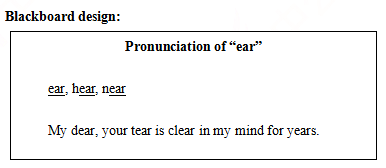 答案:解析:暂无解析
答案:解析:暂无解析 -
第18题:
小学英语?语音
一、考题回顾
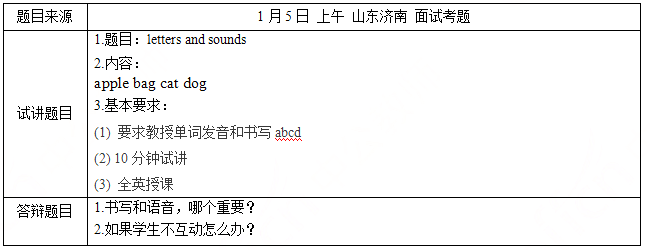
二、考题解析
【教案】
Teaching aims:
Knowledge aim:
Students will know the meaning of the four words and master the pronunciation of them.
Ability aim:
Students will know how to write the letters ABCD correctly.
Emotional aim:
Students will be more confident in speaking English.
Students will arouse their interest in learning oral English.
Key and difficult point:
Key Point:
Students will know the meaning of the four words and master the pronunciation of them.
Students will know how to write the letters ABCD correctly.
Difficult Point:
Students will be more confident in speaking English.
Students will arouse their interest in learning oral English.
Teaching procedure:
Step 1: Warming-up
1. Greetings. Talk about the weather.
2. Sing a song called ABCD.
Step 2: Presentation and practice
1. Write down four pictures one by one to explain the new words. Teach them how to pronounce each word clearly.
2. Ask the students to read each word after the teacher for twice. Then play high and low voice with them. If the teacher read one word loudly, the students should read it slowly, and vice versa.
3. Let them notice the first letter of each word and ask what they are. They may answer it is the first four letters in the alphabet. Then teach them how to write them in upper and lower case one by one.
4. Ask students to play a game called Act and Write. They need to work in groups of 3. One or two students need to form a letter with their bodies. The other student should guess what it is and write down on the blackboard.
Step4: Production
1. Ask the students to make up sentences according to the words learned today. Then write them down on the blackboard. Correct mistakes if any.
Step5: Summary and Homework
Summary: ask a student to conclude the content of the lesson and summarize with the whole class.
Homework: ask students to play act and write with their parents.
Blackboard design:
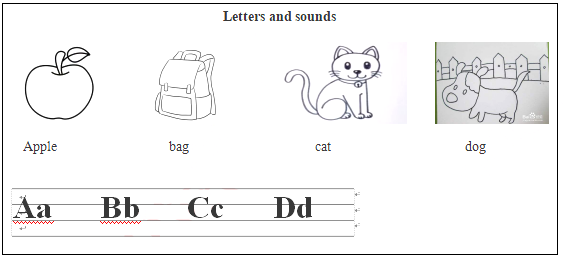
1. Which is more important in the lesson, pronunciation or writing?
2. What will you do if the students do not interact with you?答案:解析:1.
I think pronunciation and writing are equally important in the lesson. Students could learn and remember the words easily if they know how to pronounce the words. And if they know how to write the letters, they will know how to write the words down gradually. These procedures could help students remember and use the words, so they are all crucial for students.
2.
There are several ways to deal with the problem. First, I could arrange more interesting activities to arouse their interest, so that their attention could be attracted. Second, I could praise them more to give encouragement. In this way, they will get positive feedback from the teacher and be more willing to study English. Third, competition is also useful to help catch their eyes. The above ways are conducive to let them interact with you. All you have to do is to choose the most appropriate way in the specific situation. -
第19题:
It is important for the teacher to show students how easy it is to understand something from authentic materials rather than how difficult it is to understand everything.()
正确答案:正确 -
第20题:
单选题How should the teacher deal with students' writing errors?ATeachers should limit students to take risks to use new vocabulary and structures.
BTeachers should often show negative attitude towards students' writing errors.
CTeachers should make corrections for all the writing errors of students.
DTeachers should underline the errors and leave them for students to correct themselves.
正确答案: B解析: -
第21题:
判断题It is important for the teacher to show students how easy it is to understand something from authentic materials rather than how difficult it is to understand everything.()A对
B错
正确答案: 对解析: 暂无解析 -
第22题:
单选题The teacher gives students 2 minutes to skim a text,and when time is up,he asks students to stop and answer some questions.Here the teacher is playing the role of a(n)_______.Aassessor
Bprompter
Cparticipant
Dcontroller
正确答案: C解析: -
第23题:
单选题Before doing a writing task, the teacher elicits students' ideas by asking them to list as many words or phrases that come into their mind about the topic as possible.Here the teacher is playing the role of a(an) ____.Acontroller
Bparticipant
Corganizer
Dprompter
正确答案: A解析:
